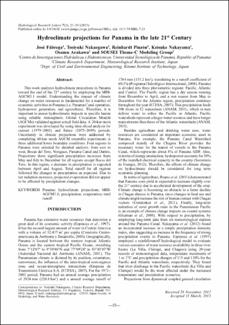Hydroclimate projections for Panama in the late 21st Century
Fecha
2013-03-312013-03-31
Autor
Fábrega, José
Nakaegawa, Tosiyuki
Pinzón, Reinhardt
Nakayama, Keisuke
Arakawa, Osamu
Metadatos
Mostrar el registro completo del ítemResumen
This work analyzes hydroclimate projections in Panama
toward the end of the 21st century by employing the MRIAGCM3.1 model. Understanding the impact of climate
change on water resources is fundamental for a number of
economic activities in Panama (i.e. Panama Canal operation, hydropower generation, and agriculture). Therefore, it is important to assess hydroclimatic impacts in specific basins using reliable Atmospheric Global Circulation Models (AGCMs) validated against actual field data. A 20-km mesh experiment was developed by using time-sliced analysis for current (1979–2002) and future (2075–2099) periods. Uncertainty in climate projections were addressed by completing 60-km mesh AGCM ensemble experiments at three additional lower boundary conditions. Four regions in
Panama were selected for detailed analysis: from east to
west, Bocas del Toro, Veraguas, Panama Canal and Darien.
Projections show significant precipitation increases from
May and July to December for all regions except Bocas del
Toro. In this region, a decrease in precipitation is expected
between April and August. Total runoff for all regions
followed the changes in precipitation as expected. Due to
net radiation increases, projected evaporation did not appear to be affected by precipitation changes.
toward the end of the 21st century by employing the MRIAGCM3.1 model. Understanding the impact of climate
change on water resources is fundamental for a number of
economic activities in Panama (i.e. Panama Canal operation, hydropower generation, and agriculture). Therefore, it is important to assess hydroclimatic impacts in specific basins using reliable Atmospheric Global Circulation Models (AGCMs) validated against actual field data. A 20-km mesh experiment was developed by using time-sliced analysis for current (1979–2002) and future (2075–2099) periods. Uncertainty in climate projections were addressed by completing 60-km mesh AGCM ensemble experiments at three additional lower boundary conditions. Four regions in
Panama were selected for detailed analysis: from east to
west, Bocas del Toro, Veraguas, Panama Canal and Darien.
Projections show significant precipitation increases from
May and July to December for all regions except Bocas del
Toro. In this region, a decrease in precipitation is expected
between April and August. Total runoff for all regions
followed the changes in precipitation as expected. Due to
net radiation increases, projected evaporation did not appear to be affected by precipitation changes.
